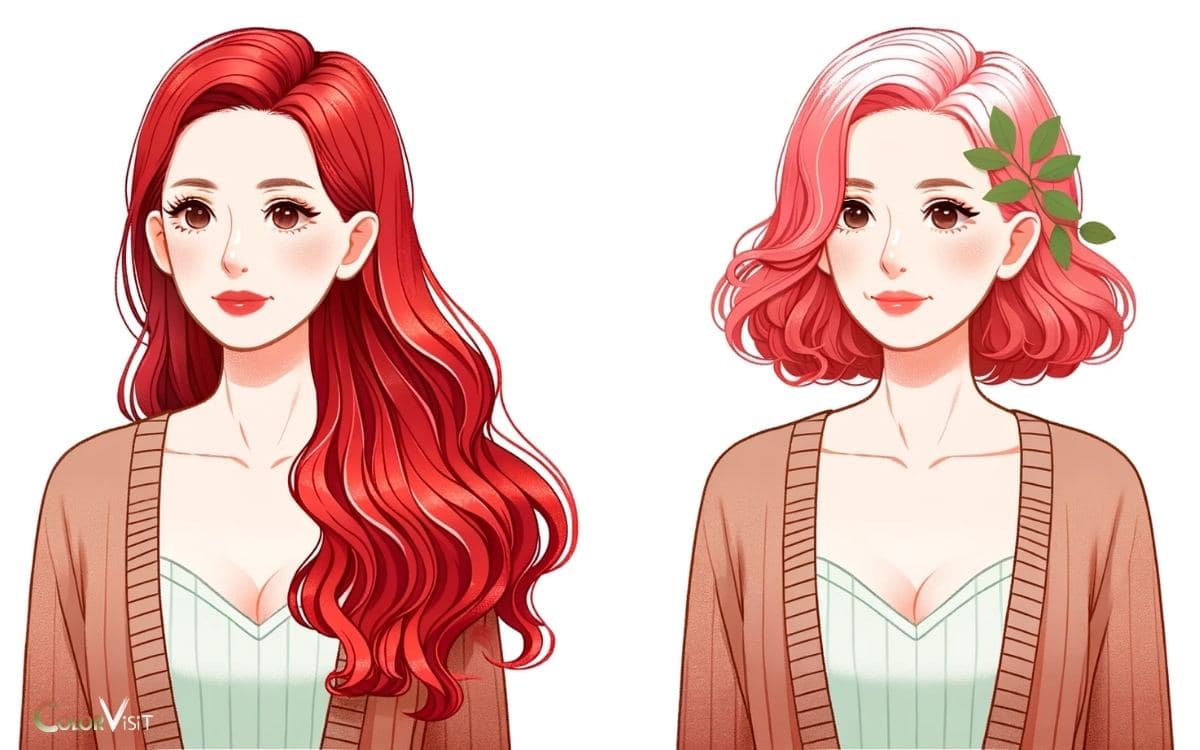What Color Does Red Hair Turn When You Get Old? Gray!
When red hair ages, it generally tends to turn white or gray, just like any other hair color. Red hair is characterized by the presence of the pigment pheomelanin, which gives it its distinctive hue.
Over time, the production of this and other pigments, including eumelanin, diminishes due to aging.
The graying process is universal and affects all hair colors as the melanocytes, the cells responsible for hair pigment, decrease in number and activity.
For redheads, the process may look like the following:
Redheads may notice their vibrant tresses take on a softer hue with time, reflecting a natural shift that’s as unique as their fiery locks.
Key Takeaway
Genetic Factors Influencing Hair Color Changes
Genetic factors play a significant role in influencing the changes in hair color as individuals age.
- The production and distribution of melanin, the pigment responsible for hair color, are influenced by a complex interplay of genetic factors.
- As individuals age, the activity of the melanocyte cells responsible for producing melanin decreases, leading to a natural graying of the hair.
- Additionally, specific genes inherited from parents can determine the rate and pattern of this graying process.
- For example, variations in the MC1R gene have been linked to the production of red hair and are also associated with how individuals’ hair color changes as they age.
Understanding these genetic factors provides valuable insight into the natural processes that influence hair color changes, allowing individuals the freedom to embrace and appreciate the unique characteristics of their aging hair.
Impact of Sun Exposure on Aging Red Hair
As individuals age, the impact of sun exposure on aging red hair becomes a significant factor influencing the maintenance of its color and overall health.
Understanding the impact of sun exposure on aging red hair is crucial for implementing protective measures to maintain its color and health over time.
The following points provide insight into the effects of sun exposure on aging red hair:
- Fading: Prolonged sun exposure can cause red hair to fade, leading to a loss of vibrancy and richness in color.
- Dryness and Brittleness: The sun’s UV rays can strip the hair of its natural oils, leading to dryness and brittleness, which can make red hair appear dull and lifeless.
- Increased Vulnerability to Damage: Aging red hair is more susceptible to damage from the sun, such as split ends and breakage, which can further alter its appearance and texture.
Role of Hormonal Changes in Red Hair Transformation
The impact of hormonal changes on aging red hair’s transformation can be significant, affecting its color and texture over time.
- As individuals age, hormonal fluctuations can lead to a decrease in the production of melanin, the pigment responsible for red hair.
- This reduction in melanin can cause red hair to fade, losing its vibrant hue and appearing more muted or even turning blondish or white.
- Additionally, hormonal shifts can also influence the texture of red hair, making it coarser or thinner.
- The decrease in estrogen levels during menopause, for example, can contribute to hair thinning and brittleness.
Understanding the role of hormonal changes in red hair transformation is crucial for individuals seeking to maintain the vitality and health of their unique hair color as they age.
Dietary and Lifestyle Influences on Red Hair Evolution
Research indicates that dietary choices and lifestyle factors play a significant role in influencing the evolution of red hair as individuals age.
The following are key influences on the transformation of red hair color:
- Nutritional Intake: Consuming a diet rich in certain nutrients, such as vitamin E, copper, and zinc, can help maintain the vibrancy of red hair as individuals grow older.
- Sun Exposure: Prolonged exposure to sunlight can cause red hair to lighten over time. Protecting the hair from UV rays through hats or sunscreens can help preserve its natural red hue.
- Chemical Exposure: Regular use of hair dyes, styling products, and heat treatments can impact the color and texture of red hair. Choosing gentle, natural hair care products and minimizing chemical treatments can aid in preserving the redness of the hair.
Understanding the Graying Process in Red Hair
One significant determinant in the graying process of red hair is the gradual reduction in melanin production within the hair follicles.
Melanin, the pigment responsible for hair color, diminishes with age, leading to the appearance of gray hair. In red hair, the graying process is particularly noticeable due to the contrast between the red and gray colors.
The following table illustrates the typical graying process in red hair:
| Age (years) | Percentage of Gray Hair |
|---|---|
| 30 | 10% |
| 40 | 25% |
| 50 | 50% |
| 60 | 75% |
As red hair turns gray, it undergoes a series of color shifts, resulting in a blend of red and silver strands. The unique characteristics of red hair can make the graying process especially striking and beautiful.
Conclusion
Red hair can turn lighter or even white as individuals age due to genetic, environmental, and hormonal factors.
Interestingly, research has found that approximately 70% of people with red hair will experience some degree of graying by the age of 50.
Understanding the factors that contribute to the transformation of red hair can help individuals better care for and embrace their changing hair color as they age.

